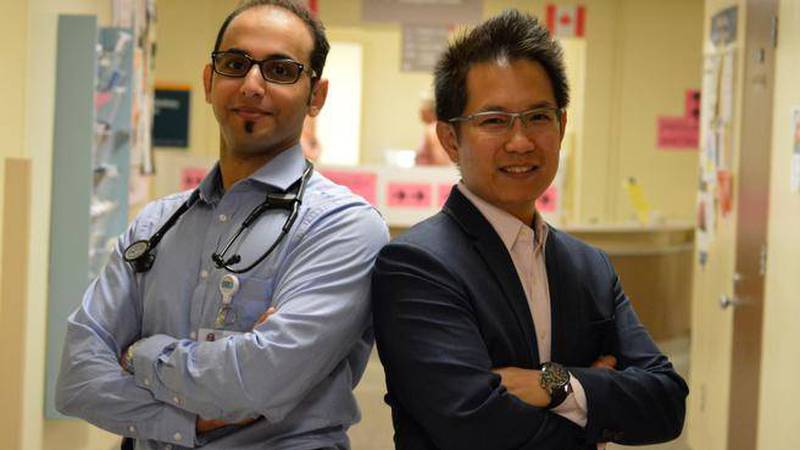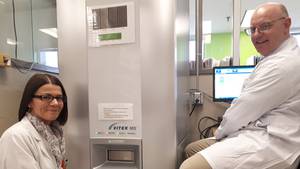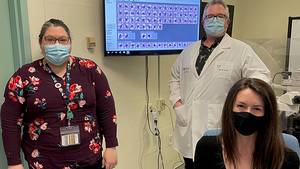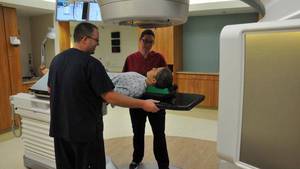Having lived with Type 1 diabetes for close to 20 years, Dr. Bader Alamri understands more than most the need to have a good medical team when dealing with a life-long disease.
Originally from Saudi Arabia, Dr. Alamri, a second-year internal medicine resident at Dalhousie University, moved several times while growing up and quickly discovered that his disease, which generally develops in childhood or adolescence and is treated with insulin, was better controlled when it was properly managed. Dr. Alamri found what he was looking for at the QEII Health Sciences Centre when he moved to Halifax two years ago to further his medical training, with the goal of one day helping patients like himself.
“I have to disclose that I am biased because I love them all,” Dr. Alamri says of his diabetes care team, which includes an endocrinologist, a nurse and dietician.
At the QEII, the diabetes care team provides specialized management of the disease for patients across the province by working closely with primary care providers and the Diabetes Care Program of Nova Scotia (DCPNS). The QEII’s team treats adult patients of all ages, from newly diagnosed patients with Type 1 diabetes to individuals who have had long standing diabetes and who have suffered multiple complications such as renal failure requiring a kidney transplant.
DID YOU KNOW?Type 1 diabetes: Type 1 diabetes occurs when no, or very little, insulin is released into the body. Always treated with insulin, Type 1 diabetes generally develops in childhood or adolescence but can develop in adulthood. Type 2 diabetes: Type 2 diabetes happens when the body cannot properly use the insulin that is released or does not make enough insulin. Type 2 diabetes happens most often in adults but children can be affected. Treatment for Type 2 diabetes depends on the severity and may be managed through healthy living or may require medications including insulin. |
Nova Scotia has among the highest rates of diabetes in Canada. According to the Nova Scotia Diabetes Report 2016, 11.4 per cent or 93,000 Nova Scotians over the age of 20, are living with diabetes and up to 90 per cent of those have Type 2 diabetes. More than 5,400 new cases were identified in 2013-2014, which translates into about 450 new cases every month.
“Being overweight or obese is a significant risk factor in developing Type 2 diabetes,” says Dr. Churn-Ern Yip, an endocrinologist with the QEII’s team. Dr. Yip, along with three other endocrinologists, a diabetes nurse and a dietician, see the majority of the clinic’s close to 5,000 patients.
“The patients with diabetes that are referred to the QEII are more complicated cases than those who are seen only by the DCPNS,” says Dr. Yip.
About 40 per cent of Dr. Yip’s patients have Type 1 diabetes, like Dr. Alamri, and need to be followed for years. His other patients have Type 2 and may only need to be seen for a short time. For example, after he has achieved the individualized patient’s blood glucose target, they typically return to the care of their family doctor and one of several diabetes management centres in the province.
Dr. Alamri credits Dr. Yip and his team for providing him with the best care, often giving him articles to read about the latest diabetes studies, research and dietary information. Now on an insulin pump and a CGM that continuously monitors his glucose levels, gives real-time readings, and provides him with more precise amounts of insulin, Dr. Alamri considers his diabetes to be stable.
“They are on top of everything,” he says of the diabetes team.
Always looking at advances in diabetes care, Dr. Yip is excited about a new technology that will be available to his patients in the next few months. The new glucose sensing technology for adults with diabetes is a system that records sugar without the need for routine blood glucose checking and reads glucose levels through a sensor that can be worn on the back of the upper arm for up to two weeks. Known as a flash glucose monitoring system it measures sugar levels constantly and can displays the results immediately. Health Canada approved the system at the end of June (2017).
“It will help many patients manage their sugars more effectively,” Dr. Yip says.








